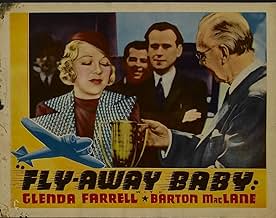Ajouter une intrigue dans votre langueTorchy Blane tries to solve a murder and smuggling case during a round-the-world flight.Torchy Blane tries to solve a murder and smuggling case during a round-the-world flight.Torchy Blane tries to solve a murder and smuggling case during a round-the-world flight.
Joe King
- Mr. Guy Allister
- (as Joseph King)
Glen Cavender
- George - Globe Chop House Manager
- (uncredited)
Lane Chandler
- Policeman Announcing Miss Sayre
- (uncredited)
Don Downen
- Herald Copy Boy
- (uncredited)
Earl Dwire
- Globe Chop House Waiter
- (uncredited)
Eddie Graham
- Man at Bar with Sprague
- (uncredited)
Histoire
Le saviez-vous
- AnecdotesThough released six weeks after the Hindenburg disaster, which put a stop to all commercial dirigible flights, the film's climax occurs on a German dirigible and it contains stock footage of the Hindenburg (LZ-129).
- GaffesThe map of Torchy's flight "shows" it ending in Frankfurt, Germany, but it's actually flying to Berlin. Frankfurt, where Zeppelin flights took off from and arrived at, is much farther to the west.
- Citations
Sgt. Orville Gahagan: [to a gaggle of reporters trying to get into the crime scene, including Torchy] Orders is no reporters, male or female - especially female!
- ConnexionsEdited from Flirtation Walk (1934)
Commentaire en vedette
Its rather amazing that this series isn't more widely seen.
Superficially, they are B movies and at the cheapy end. They have incredibly uninteresting stories, stuff about the mob.
But they're really impressive in a way. I guess it doesn't register today, but these were either important in their day or if you wish reflected something important.
For non-US readers, you have to know that women couldn't vote until very late in the history of the US. Blacks first, then women. The time of this movie is five times further away from us than it is from the first national election where women voted.
A woman could be a wife, a nurse, teacher, secretary, whore.
Or, in movies if she was bright, a newspaper reporter. You have to understand also that the thirties was a period of great experimenting in narrative folding: stories that in some way included the making of stories. One common fold was the newspaper guy who "got the story" just as we are. He was our avatar, our representative in the thing.
These experiments from the thirties played with different notions of storygetter, some comic, some inverted.
So here you have a bright woman reporter. Feisty. Pretty. She's engaged to an "official" detective, a cop. But she keeps missing the wedding because she goes off chasing the story.
Together, they get the crook and solve the case, but always with her in the lead. He protects and she loves him, the "big lug." Though this is black and white, the audience would know (from posters, fan magazines and her name) that she is redheaded.
It was a long-lasting sequence of movies, as many as, say, the Charlie Chan ones and with far more than the celebrated "Thin Man." So I invite you to watch this or any of the series. She's an icon that's all the more fascinating because it has ceased having power. Now that's interesting.
Ted's Evaluation -- 3 of 3: Worth watching.
Superficially, they are B movies and at the cheapy end. They have incredibly uninteresting stories, stuff about the mob.
But they're really impressive in a way. I guess it doesn't register today, but these were either important in their day or if you wish reflected something important.
For non-US readers, you have to know that women couldn't vote until very late in the history of the US. Blacks first, then women. The time of this movie is five times further away from us than it is from the first national election where women voted.
A woman could be a wife, a nurse, teacher, secretary, whore.
Or, in movies if she was bright, a newspaper reporter. You have to understand also that the thirties was a period of great experimenting in narrative folding: stories that in some way included the making of stories. One common fold was the newspaper guy who "got the story" just as we are. He was our avatar, our representative in the thing.
These experiments from the thirties played with different notions of storygetter, some comic, some inverted.
So here you have a bright woman reporter. Feisty. Pretty. She's engaged to an "official" detective, a cop. But she keeps missing the wedding because she goes off chasing the story.
Together, they get the crook and solve the case, but always with her in the lead. He protects and she loves him, the "big lug." Though this is black and white, the audience would know (from posters, fan magazines and her name) that she is redheaded.
It was a long-lasting sequence of movies, as many as, say, the Charlie Chan ones and with far more than the celebrated "Thin Man." So I invite you to watch this or any of the series. She's an icon that's all the more fascinating because it has ceased having power. Now that's interesting.
Ted's Evaluation -- 3 of 3: Worth watching.
- tedg
- 9 août 2006
- Lien permanent
Meilleurs choix
Connectez-vous pour évaluer et surveiller les recommandations personnalisées
Détails
- Date de sortie
- Pays d’origine
- Langues
- Aussi connu sous le nom de
- Fly-Away Baby
- Lieux de tournage
- société de production
- Consultez plus de crédits d'entreprise sur IMDbPro
- Durée1 heure
- Couleur
- Mixage
- Rapport de forme
- 1.37 : 1
Contribuer à cette page
Suggérer une modification ou ajouter du contenu manquant

Lacune principale
By what name was Fly Away Baby (1937) officially released in Canada in English?
Répondre


































